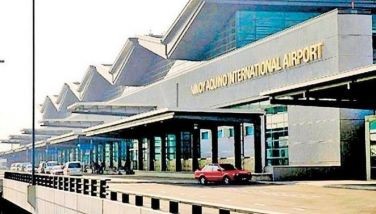Philippine nuclear program faces brighter prospects

MANILA, Philippines — Despite opposition, the country’s nuclear power program faces brighter prospects under the new administration as president-elect Ferdinand Marcos Jr. openly supports the inclusion of nuclear power in the energy mix.
The adoption of nuclear power, as well as revisiting the mothballed 620-megawatt (MW) Bataan Nuclear Power Plant (BNPP), was a campaign promise of Marcos and his running mate Davao Mayor Sara Duterte.
Last week, South Korean Ambassador Kim Inchul met with the then presumptive president to express his country’s support for the incoming administration – including the offer to help in reviving the country’s first and only nuclear power plant.
In 2008, state-owned power generation firm Korea Hydro & Nuclear Power conducted a pre-feasibility, in partnership with the National Power Corp. (Napocor), to rehabilitate BNPP.
This was followed by another pre-feasibility done in 2017 under a cooperation agreement with the Department of Energy (DOE).
If the government wants to introduce nuclear power as soon as possible, reviving the BNPP would be the way to go, Philippine Nuclear Research Institute (PNRI) executive director Carlo Arcilla said in an interview with The STAR.
“Reviving the BNPP is the fastest because the facility’s already there, then the South Koreans are ready to move in,” he said.
South Korea operates a nuclear plant that is an exact twin of the BNPP. The nuclear power plants with the same design are in Slovenia and Brazil.
The South Korean proposal is to invest $1.1 billion to $1.2 billion to reopen the BNPP – roughly the same amount needed to put up a coal-fired power plant with the same capacity.
“If we reopen the BNPP, the fuel will cost is something from $20 million to $25 million. It is small and will fit in a small jeepney and will last for 18 months. In contrast, if that were a coal plant operating for 18 months, it would require 50 Panama ships from $700 million to $800 million,” Arcilla said.
“Savings alone in the running of the plant versus a coal plant, you can recover the investment as soon as two years,” he said.
Another option for the country is the possible entry of small modular reactor (SMR) technology.
“New plants, but not the big ones. The best option for the Philippines – even DOE shares this – is the small modular reactors for off-grid areas or even for the main Luzon Island. These have 70 to 100- megawatt (MW) capacities,” Arcilla said.
Unlike big nuclear plants, the SMRs are already complete when manufactured and can fit in a big truck when transported. This would also mean that its deployment would no longer have delays due to construction, the PNRI official said.
“The problem with SMRs is they (the US) have not yet built one running unit yet because they don’t need one. They have 95 nuclear plants. But for the Philippines, which is an archipelagic country, it’s perfect,” he said.
Through the Executive Order 164 signed by President Duterte last Feb. 28, the country has now adopted a national position for a nuclear energy program – the first of the 19 issues laid down by the International Atomic Energy Agency (IAEA), the United Nation’s nuclear watchdog, that require specific actions before a country can launch its nuclear program.
Arcilla said the country now needs to lay down a legal framework and establish an independent regulatory body for nuclear power.
The PNRI is currently the only existing regulator for nuclear energy in the country. It is under the Department of Science and Technology (DOST) and only cover the 3S – Safety, Security and Safeguards.
“We need a strong, independent regulator, who can tell nuclear operator to stop if they’re not doing things right, and who should be free from pressure even from the president,” Arcilla said.
However, think tank Center for Energy, Ecology, and Development (CEED) is against the introduction of nuclear in the country – more so the revival of BNPP – as this is detrimental to the environment and economically unsound.
“Duterte signed an executive order that would make it easier for…president (elect) Marcos to dwell on his fixation for nuclear power, despite its clear incompatibility to disaster-prone Philippines,” CEED executive director Gerry Arances said.
Harnessing nuclear energy and reviving the BNPP, in particular, is “alarming” as this goes against the country’s push to shift to clean energy, Greenpeace said.
“Pursuing nuclear energy will be a distraction from achieving energy transition, as this could derail investments on renewable energy, undermine ongoing policy efforts and bring in risks of nuclear waste, nuclear meltdown and even propel high electricity prices,” Greenpeace Southeast Asia climate and energy campaigner Khevin Yu said.
Citing a 2020 report by Lazard, Yu said the Levelized Cost of Operating Energy (LCOE) of solar is around $36 to $44 per megawatts hour (MWh), while nuclear is at $112 to $189 per MWh.
“Nuclear energy will be too risky to operate in the Philippines considering that we are constantly battered by climate change impacts and other disasters, which could compromise the operation of a nuclear power plant,” he said.
Besides, Manila-based policy group Institute for Climate and Sustainable Cities (ICSC) believes going nuclear is not the answer in the current Philippine power setting – which is toward renewable energy development.
In an interview with ANC on May 24, ICSC energy transition adviser Alberto Dalusung III said the country’s power grid needs flexible power generation from renewables to support the variable power requirements of the country.
And nuclear power plants are inflexible since it is a baseload plant – or a plant supplies power 24/7.
“To build a nuclear power plant, we operate it at its capacity and you don’t ramp it up (and) you don’t ramp it down. I think I’ve said before that that’s not what our grid needs,” he said.
- Latest
- Trending
































